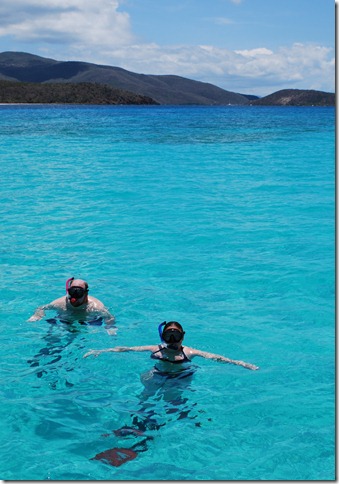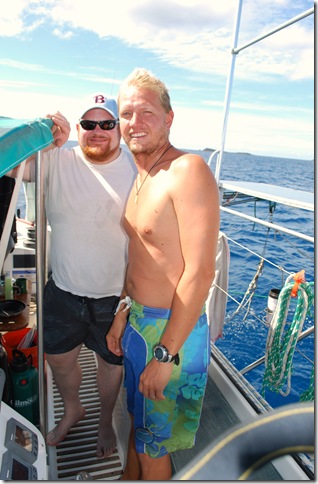Lat: 22 04.304′ N
Lon: 70 20.572′ W
For some reason, Lauren and I were really dreading this passage before leaving. Maybe it was because we got so many full nights of sleep in the Caribbean, or maybe it was not having a new, exciting destination to sail to next. As it turns out, it’s been really pleasant so far, and we were into the passage less than a day before we were both glad to be out here and enjoying our final days at sea. Passagemaking is incredibly stress-free and relaxing as long as the weather is nice and there are no major boat hassles to sort out. I’m not sure what I’m going to do when I can’t count on getting to sea on a regular basis to chill out.
Every passage is different, and so far this one has been unique for the amount of motoring we’re doing. We got lucky and were able to sail for about the first 12 hours, but since then we probably haven’t had the engines off for more than 30-60 minutes at a time and have been running one for nearly all of the last two and a half days. We took on fuel before leaving the BVI’s, but we were hoping to sail at least half the time, so we’re seriously having to consider making a fuel stop in San Salvador if we don’t find more wind. I really thought that the fuel I bought in Brazil would be the last, but keeping to a schedule in the Caribbean and light winds have combined to cause us to go through quite a bit of it.
We’ve had a pretty large northerly swell most of the time, which has been interesting with so litle wind. Swell can mean a number of things, but in this case I’m referring to waves that have most likely travelled hundreds or thousands of miles to get here. Since they’re "old" waves, their period has lengthened, making them long, slow rollers. Even though they’re 6 feet or more and coming right toward us, we just glide up and over them instead of crashing into them. There’s been virtually no wind at times, causing the surface of the ocean to take on an oily, surreal sheen in which you can see the clouds reflected. It’s sort of unique for us to have that ocean surface look combined with large swells. It looks sort of like big jelly mirrors oozing and sliding around us.
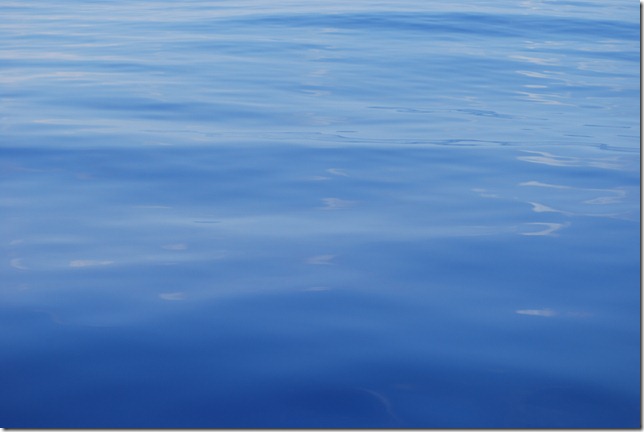 Being surrounded by this is a really surreal experience
Being surrounded by this is a really surreal experience 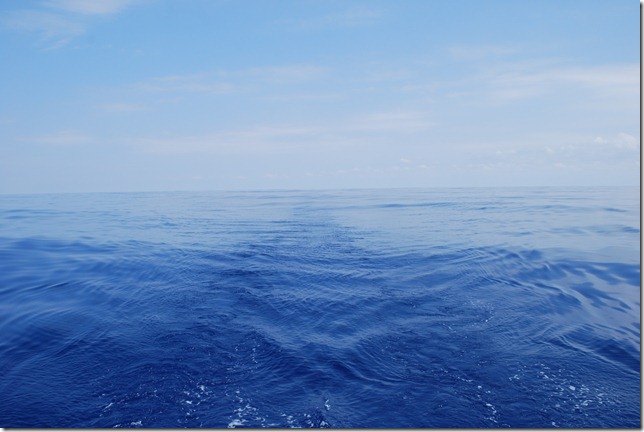 Superposition patterns from the wakes from our hulls
Superposition patterns from the wakes from our hulls
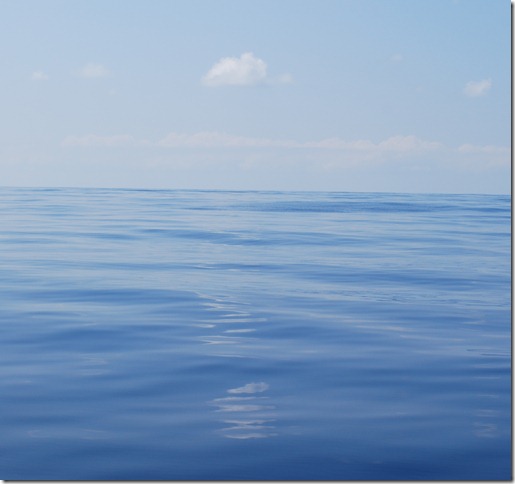 A cloud reflecting off the water. When it was hazy it was hard to make out the line of the horizon.
A cloud reflecting off the water. When it was hazy it was hard to make out the line of the horizon.
At this point just starting to sail past the Turks and Caicos, about 50 miles off to port. We saw the glow from Puerto Rico the first two nights we were out, but I’m guessing we’re not going to see much from the Turks and Caicos. The air is definitely getting cooler as we sail farther north, and the combination of fair skies and cool breeze reminded me of a nice spring day back in the Midwest.
As for the crew, we’re definitely preoccupied with thoughts of our imminent return to the US. As one South African we met in Tortola said when he heard about our trip, "I’m in eempreessed, but what ah ya going to do neext?"
Lat: 19 49.306’ N
Long: 66 50.661’’ W
We had to say good-bye to Kope and Julia and to the Virgin Islands on Tuesday. We packed in a lot of activity while they were here, much of it underwater, so I think they were looking forward to enjoying the creature comforts of their hotel room in St. Thomas for a couple of nights before heading back to work.
In case we haven’t made our case for the Virgins yet, they really are ideal for cruising and diving. We ended up diving six times while there, and each site had something new to offer. The RMS Rhone was site of choice for Julia and I. Nearly all of the sites had an abundance of soft corals (fans, plumes), but here there were lots of hard corals as well that really added to the visual array. In addition to bright red, orange, and even blue hard corals growing on the steel structure of the wreck, there were lots of tube sponges protruding outward, most of them light purple. There was no shortage of fish, either, many of them Sergeant Majors. These medium-sized fish are typically white with a yellow upper body and black vertical stripes, but occasionally we saw the blue variety, which is the same fish but in the blue phase, indicating that it’s a male guarding eggs. I have a few photos of the fish and the site to post that don’t do justice to the landscape but will give you a better idea.
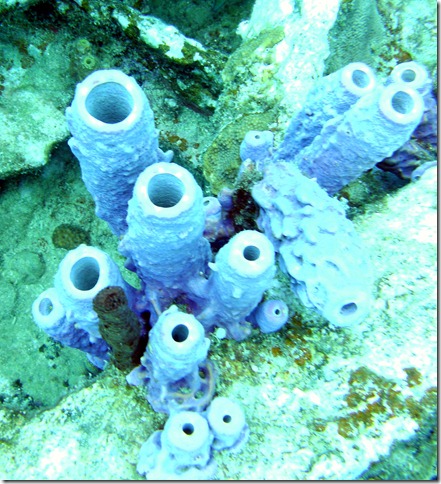 For whatever reason, there were a bunch of these at the Rhone
For whatever reason, there were a bunch of these at the Rhone
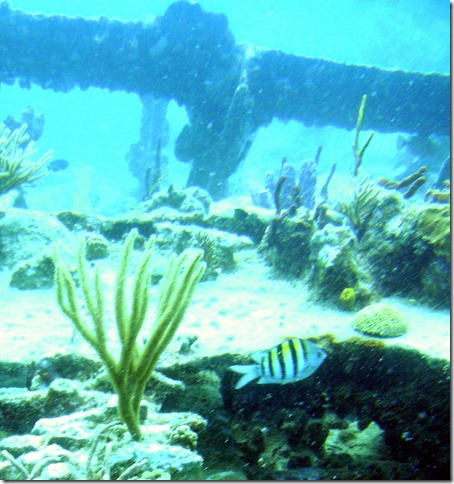 Sergeant Major with propeller shaft of the RMS Rhone in background
Sergeant Major with propeller shaft of the RMS Rhone in background
Most of our evenings, as Dallas noted, were spent on the boat under the stars. On Sunday night, however, we got a taste of local culture at the Bomba Shack near the West End of Tortola. This place was very Caribbean – open air, sand floors, people’s names written all over the wooden frame that comprised the shack in black marker, and even a few items of women’s underwear that were somehow left behind. (After sampling the Bomba Punch, we got a better idea as to how that happened!) The DJ was spinning a nice mix of dance, reggae, and pop, and Julia and I worked off our Bomba’s barbeque dinner by hilariously (to us) trying out our dance moves in the soft, deep sand. Initially it was just us and a few locals there, but a couple of groups of tourists popped in briefly and joined in the fun. The shack isn’t near the resorts and is in a bay that’s not suitable for anchoring, so cruisers/tourists have to take a taxi there, but Bomba has managed to put itself on the BVI map with its unique vibe and monthly full-moon parties.
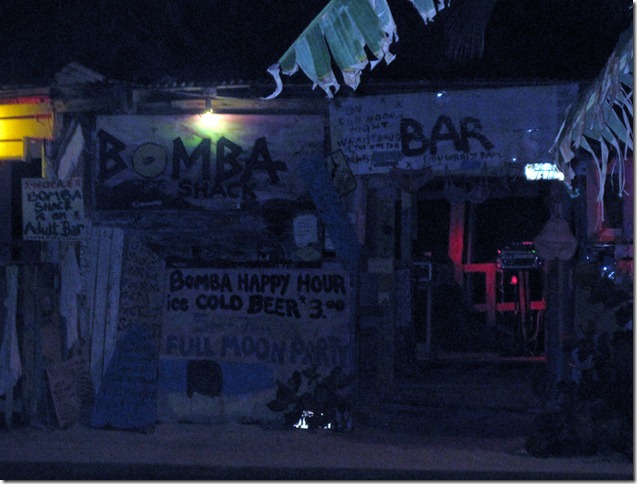 As the sign reads, “Bomba Shack is an Adult Bar”
As the sign reads, “Bomba Shack is an Adult Bar”
So now Dallas and I are back at sea, a place with which we have grown very familiar and comfortable. However, we weren’t looking forward to this passage in particular as the forecast indicated that we would have minimal to light winds for the bulk of the 900 miles. So far the weather report has been accurate (we’ve been motoring for most of the last two days), but now that we are out here, we are just relaxing and appreciating what is to be the last long (multi-day) passage of our circumnavigation. It is hard to believe that we are so close.
Fortunately, we have one last bit of paradise to experience, the Bahamas. We are looking forward to being joined in the Bahamas by Dallas’ brother Tim, his wife Heather, and their two young children, so we will get a chance to expose more people to some of the activities that have brought us so much pleasure over the last couple of years!
Well, this blog is going to pretty much be a repeat of the last blog with different place names inserted. Cue sunny skies, snorkeling, scuba diving, beautiful starry nights at anchor, etc. We’re here at the beginning of the low season, so things aren’t ridiculously crowded like they can be at other times, but you can definitely see why they get that way. The Virgins are a lot like the Vava’u group in Tonga, but with less dangerous reefs and a lot more tourist infrastructure. Beautiful anchorages are plentiful, the water isn’t the best we’ve seen, but you can generally find at least 50’ of visibility, reefs for snorkeling and diving are plentiful, and you can take your pick between anchorages with little to nothing ashore, ones with a small town, or ones with just a few beach bars/restaurants. The Virgins are pretty hyped in the sailing world and they’ve lived up to it for us in terms of days full of protected sailing (mostly motoring for us, unfortunately) and a nice choice of anchorages to duck into for the night.
There are some really nice beaches here, but the culture ashore isn’t really akin to the Pacific or anything, so we’ve been spending a lot of time in the water, which in our opinion is really where the action is (in addition to the lively and loud beach bars). The next good dive site is never more than a mile or two away and they’re all set up with moorings. Kope and Julia have really taken to the water amazingly well, especially considering Kope had barely snorkeled before arriving a week ago.
We left Cane Garden Bay at 5:30am, hoping to make Anegada’s huge, isolated Horseshoe Reef at a decent hour, but even though the winds were light, motoring into them and the current was making for some slow progress so we changed plans. The area around Virgin Gorda sound looked pretty promising and when arrived we found that we weren’t the only ones who thought it looked like paradise. Sir Richard Branson bought an entire island, Necker Island, which is surrounded by gorgeous reef-filled water and has a small sandy island you can swim to. Although the island is private (it rents for $26,000-$51,000/night), our guide said we could anchor there, so we motored over, slipped past the “private”-labeled mooring buoys, and snuck into a big sandy patch covered by crystal-clear water. We dropped the hook with only a couple feet of water under the keels and jumped in to snorkel. Every time we snorkel or dive, we seem to see some sort of fish we’ve never seen or noticed before or have a some kind of cool sighting. This time it was a huge lobster, some really big barracuda, conch, some cool reef fish, and a close-up encounter with a southern stingray that was hanging around the boat when we got back.
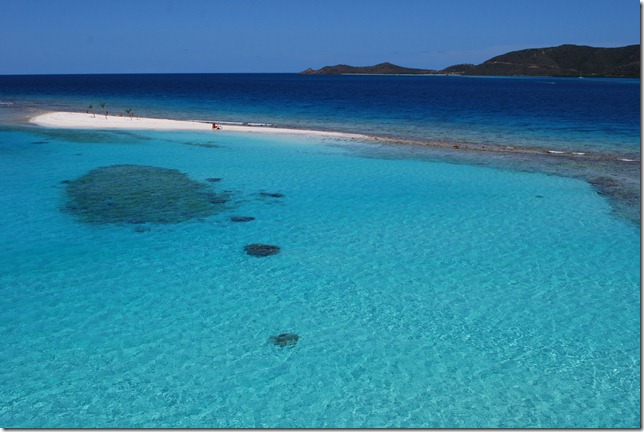 Julia snapped this pic of the lagoon around Branson’s Island from the top of the mast
Julia snapped this pic of the lagoon around Branson’s Island from the top of the mast
Our next stop was a mooring off of the Bitter End Yacht Club for some much-needed showers and a swim in the pool before crashing early. The showers brought back memories of Opua, New Zealand. They were $3 for 4 minutes and you couldn’t even get cold water once your 4 minutes was up. I guess it keeps people moving along when all 70 moorings are full. Luckily, after 2 years of taking boat showers, 4 minutes leaves me a with a couple of minutes left to just enjoy the warm water.
The next day we motored out to The Invisibles, a formation made from two large rocks just east of Necker Island. It looked like a good dive spot from the charts and the dive shop by the yacht club confirmed that it was great for underwater life. There were tons of fish and we spotted a nice sea turtle as well. We’ve been lucky enough to see either a green or hawksbill turtle almost every day, and although lots of the coral here is brown or gray, it has been plentiful at most sites and more colorful and interesting corals are scattered here and there as well.
After diving The Invisibles, we headed for The Baths, one of the must-see BVI stops. The Baths, at the SW tip of Virgin Gorda, are an area where several small beaches are framed by large, eroded granite boulders that form beautiful formations starting on the hillsides and ending underwater, where you can snorkel among them in water with good visibility. We were there just before sunset, when most of the moorings were empty, and enjoyed the way the rays of light from the setting sun played down under the water between the giant boulders. Kope and Julia had a great sighting as a turtle swam in slow motion through the rays of light between two boulders before taking off for deeper water offshore.
Instead of heading back to Spanish Town and picking up a mooring, we took advantage of the calm weather we’ve been having and anchored right off the beach not too far north of the Baths. Lauren cooked up the last of the Barbuda lobsters to more rave reviews and then we moved outside to the cockpit and dropped the bimini so we could see the sky. It was another perfect night, with a light breeze, starry skies with occasional shooting stars, and the waves crashing on the beach. We stayed up enjoying it and listening to music until the sliver of a moon sunk below the sky.
Today has brought another round of scuba diving, this time on the famous RMS Rhone wreck and Blonde Rock, an open-water reef growing over cool rock formations. Our dive compressor has definitely been working overtime lately.
We’ve hit the water running since Brian and Julia arrived on Monday afternoon. Both the US and the British Virgin Islands offer numerous beautiful anchorages to choose from, often with healthy coral and lots of marine life to boot, and we seem to be trying to check out each one of them! Brian and Julia identify themselves as “land-lubbers” but have been keen so far to spend a good portion of their days in the water. It’s only today (Thursday) that we have come up for air.
We started out by motoring from the large and very busy (there were 3 cruise ships there at one point) harbor of Charlotte Amalie on St. Thomas to nearby Buck Island. It’s a popular spot for charter boats to bring snorkelers and scuba students, and there were two other full charter boats when we arrived. Julia was keen to scuba dive after a 10 year hiatus (Brian’s never done it and is still holding out on Dallas…), and as we were getting her geared up, we heard a student diver calling to the next boat to be rescued. Apparently he was out of air at the surface and couldn’t swim, with no dive buddy or dive-master nearby. The only dive-master who was not in plain clothes left the students he was working with on the surface to assist, leading me to suspect that the ratio of students to dive-masters is dangerously high on some of these boats. Julia, on the other hand, had her own personal instructor. Dallas helped her recall the basics and stayed alongside her during her first dive, a 190’ freighter in about 40’ of water that was intentionally sunk to serve as a reef in 1979 but has since been broken up by hurricanes. Surrounding the wreck was an impressive array of small fish, including some that neither Dallas or I had ever seen. There were also a couple of large (maybe 3’ by 1.5’) silver fish that I followed around with my camera, only to have them circle and come right at me. I thought for a fleeting moment that they might attack (you never know!), but they just buzzed by me and went on their merry way. Dallas later identified them in our fish guide as the uncommon “African Pompano”, which has a tendency to react to divers by making a brief, close pass.
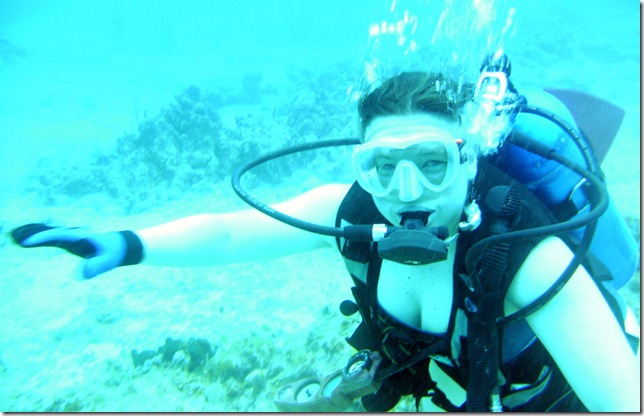 Julia didn’t realize she was going on a scuba vacation but doesn’t mind
Julia didn’t realize she was going on a scuba vacation but doesn’t mind
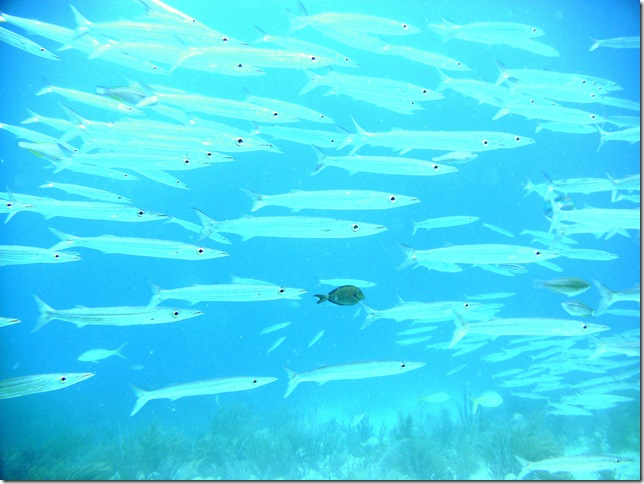 “One of these things is not like the other…”
“One of these things is not like the other…”
Brian was able to see most of what we saw as well as a sea turtle from his vantage point at the surface, and he really enjoyed it. Thus it was he who suggested that we get in one last snorkel before sunset at our next anchorage at St. James Island. There we saw two more green turtles, several types of parrotfish, and lots of varieties of coral (though mostly neutral colored). We had a nice dinner under the stars, and Dallas and Brian (AKA Kope), who have known each other since their first day of training at Raytheon 11 years ago, stayed up late drinking Scotch and catching up.
Yesterday we were back in the water by 10 a.m. at a shallow dive full of colorful corals, purple fans, and wavy plumes. The site (“Witch’s Hut”)lived up to its billing in terms of being rich with tropical fish species as well, and we spotted a large (1.5’) purple, spiny lobster sticking its long antennae out from under its rock. Julia had a chance to get really comfortable with her gear and with diving and is anxious to do more after giving her watery ears a break for a day or two.
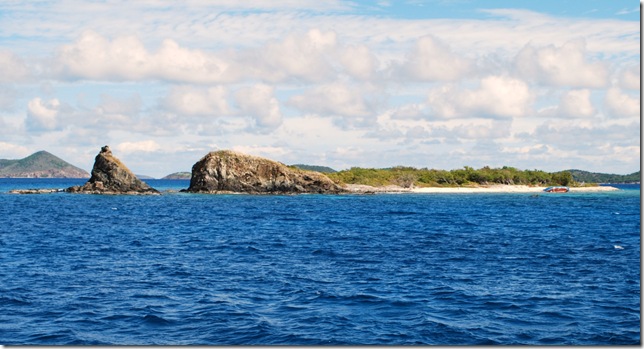 Witch’s Hut was lovely above and below the surface
Witch’s Hut was lovely above and below the surface
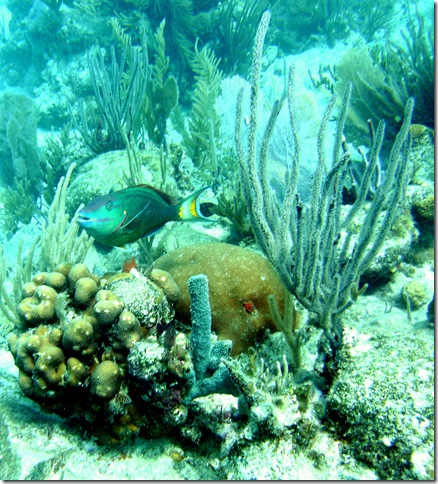 This yellow tailed parrotfish didn’t have to look hard for some coral to munch
This yellow tailed parrotfish didn’t have to look hard for some coral to munch
We made a short stop in Cruz Bay on St. John to clear out from the US Virgin Islands but decided to make one last stop in US territory at Trunk Bay on St. John. We were drawn there by the description of the underwater snorkeling trail, which we would grade a C, but the bay itself was gorgeous – definitely an A. We then entered British waters, which surprisingly look just the same! After clearing in at Tortola, the largest of the British Virgin Islands, it was on to a fairly isolated spot called Sandy Spit, a tiny little white sand island that emerged out of the clear, shallow water. We anchored close enough to it that we could hear the waves crash onto the island throughout the evening. As Kope told Dallas, “Dude, you couldn’t have parked in a better spot.” We enjoyed some of Dallas’ killer lasagna for dinner, and he and Kope entertained us with stories of their not-so-Glorious Days.
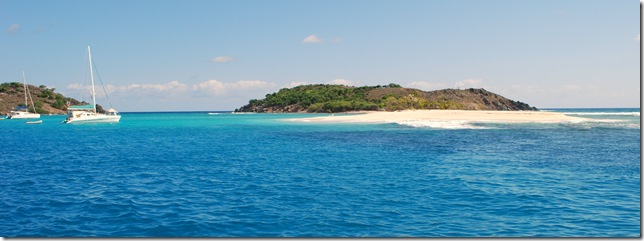 Spitting distance from Sandy Spit
Spitting distance from Sandy Spit
Today we are anchored at Cane Garden Bay on the north end of Tortola. This morning we wisely decided to take a taxi (rather than hike) up the mountain to the hiking trail at the top. The trail was part of the Sage Mountain National Park, and it was too overgrown to allow for many ocean views, but I think it was worth the effort. After the hike, we had a delicious Pain Killer drink (orange and pineapple juice, creme de coconut, and rum) at the restaurant at the base of the trail, and the British man who runs the place yarned to us about his days on the British research base in Antarctica – not somewhere that I hope to spend a lot of time, but interesting nonetheless.
After being on the go for several days, we decided to stay put for the night. We are resting up this afternoon in preparation for seeing what the BVI’s have to offer in the way of nightlife…
Returning from Nevis to South Frigate Bay in St. Kitts, we found that our formerly calm anchorage now had a swell from the south crossed with wind-driven chop from the east. The trades were finally back and it looked like a wet dinghy ride to get to shore. By splitting the ride in into two trips, we were able to get people and luggage ashore at idle speed without getting too wet. There was time enough for one more tourist stop before our last dinner, so we caught a taxi into town, enjoyed a great local lunch, and then visited the batik factory. Batik is a technique for making patterned cloth that involves creating a sort of stencil with wax put directly on the cloth and then soaking the fabric in a dye that will take where there’s no wax. By repeating the process several times with several different colors, you can end up with some cool looking designs, although the days of batik being a cost-effective production process are clearly long gone.
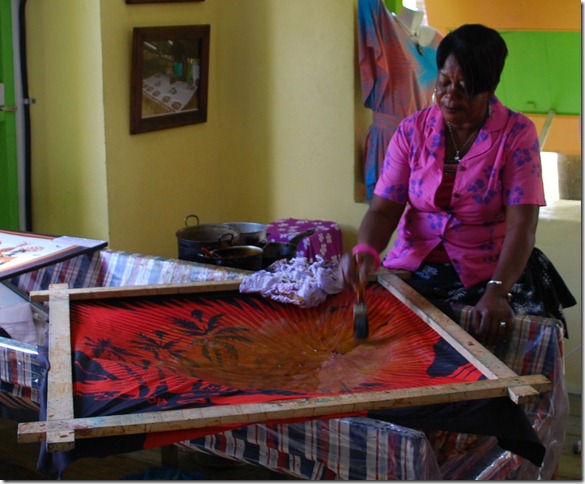 Demonstrating the wax-application stage
Demonstrating the wax-application stage
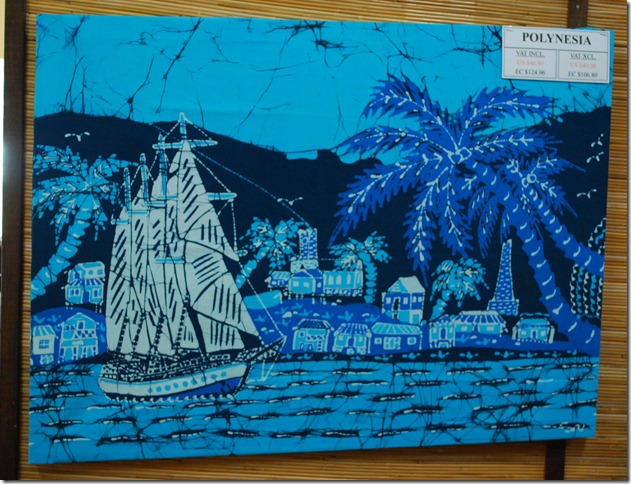 An example of the finished product
An example of the finished product
After a Barbuda lobster dinner courtesy of chef Lauren, we said goodbye to Lauren’s parents who were leaving on an early morning flight. We’ve enjoyed their visit and it’s made us a little anxious to get home and see more friends and family. The next day we did absolutely nothing worth blogging about. We didn’t even make it off the boat. The goal for the day was to decide where to sail to the next day, but we didn’t even manage to come to a final decision on that one. Oh well. You gotta have some lazy days, especially when you’re as good at it as we are.
Friday morning we decided to head for St. Croix on the way to St. Thomas, thinking we’d be able to check in on Saturday morning and save ourselves the hassle of checking in and out of the BVI. The conditions for our overnight sail were great, and we arrived at the bank that stretches east of St. Croix right around sunrise. We picked up a mooring and headed ashore, but found out that we couldn’t check in unless we took a taxi ride to the airport on the other side of the island, so we started exploring Christiansted a bit. It didn’t take long it find some action. Christiansted is a beautiful little town with old Danish buildings and a fort that are nicely painted and seem to be reasonably well preserved. There’s a waterfront that reminiscent of Key West, and a half ironman triathlon was scheduled for the next day, so the place was bustling with a strange combination of your average US tourist and ultra-fit ironman race participants. There was a definite island flavor to the place, but it also felt a lot like the states for us and so we had to take advantage of the opportunity to have real “American” breakfast and some authentic cheap, fresh Mexican food for dinner. Maybe this fitting back in won’t be so hard after all.
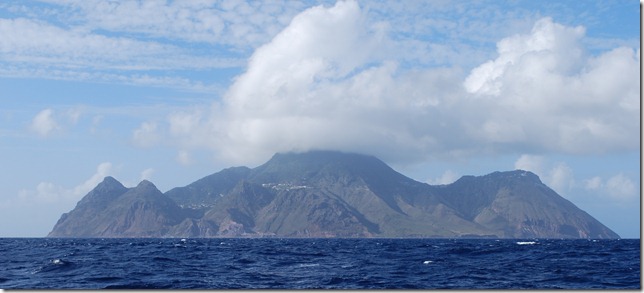 We passed the island of Saba off to starboard late in the afternoon
We passed the island of Saba off to starboard late in the afternoon
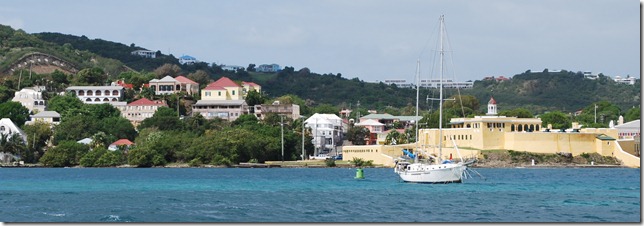 A bit of Christiansted from our mooring. What ever happened to yellow forts?
A bit of Christiansted from our mooring. What ever happened to yellow forts?
Just after the last of the triathlon swimmers swam by the mooring field, we headed north for St. Thomas where our good friends Brian and Julia are going to meet up with us tomorrow for a week here in the Virgins. St. Thomas doesn’t seem to have the incredible reef and that borders St. Croix, but it’s beautiful and verdant and we’ve already seen some great beaches. As we approached Charlotte Amalie, we could easily see St. Johns and the islands of the BVI right next door. As long as the weather cooperates it should be another fun and active week.


